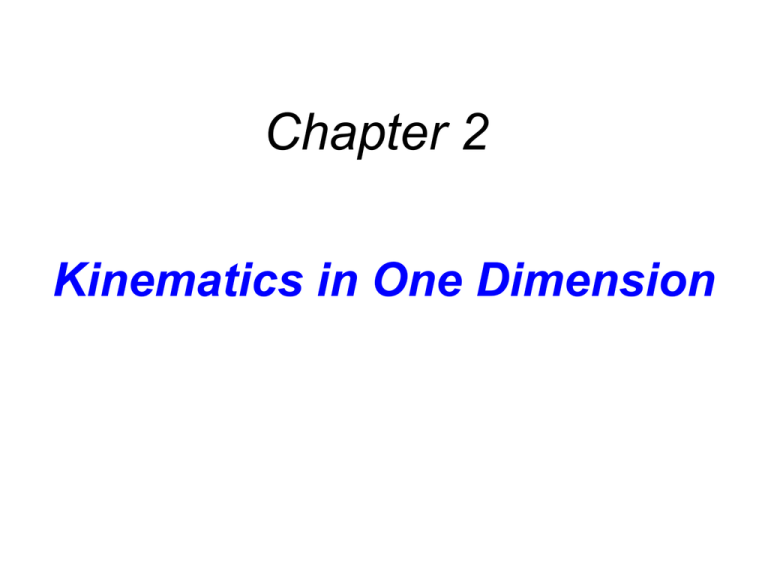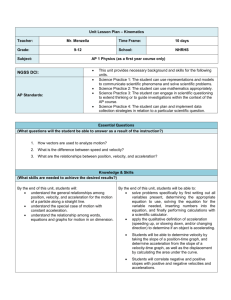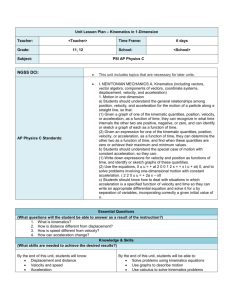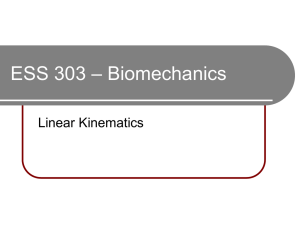2.2 Speed and Velocity
advertisement

Chapter 2 Kinematics in One Dimension Kinematics deals with the concepts that are needed to describe motion. Dynamics deals with the effect that forces have on motion. Together, kinematics and dynamics form the branch of physics known as Mechanics. 2.1 Displacement x o initial position x final position x x x o displaceme nt 2.2 Speed and Velocity Average speed is the distance traveled divided by the time required to cover the distance. Average speed Distance Elapsed time SI units for speed: meters per second (m/s) 2.2 Speed and Velocity Average velocity is the displacement divided by the elapsed time. Average velocity Displaceme Elapsed v x xo t to nt time x t 2.2 Speed and Velocity The instantaneous velocity indicates how fast the car moves and the direction of motion at each instant of time. v lim t 0 x t 2.3 Acceleration DEFINITION OF AVERAGE ACCELERATION a v vo t to v t 2.4 Equations of Kinematics for Constant Acceleration Five kinematic variables: 1. displacement, x 2. acceleration (constant), a 3. final velocity (at time t), v 4. initial velocity, vo 5. elapsed time, t 2.4 Equations of Kinematics for Constant Acceleration Equations of Kinematics for Constant Acceleration v v o at x 1 2 v o v t v v 2 ax 2 2 o x vot 1 2 at 2 2.6 Freely Falling Bodies In the absence of air resistance, it is found that all bodies at the same location above the Earth fall vertically with the same acceleration. If the distance of the fall is small compared to the radius of the Earth, then the acceleration remains essentially constant throughout the descent. This idealized motion is called free-fall and the acceleration of a freely falling body is called the acceleration due to gravity. g 9 . 80 m s 2 or 32 . 2 ft s 2 2.6 Freely Falling Bodies g 9 . 80 m s 2 Example 2.1 • You are driving your new sports car at a velocity of 90km/h, when you suddenly see a dog step into the road 50m ahead. You hit the brakes hard to get maximum deceleration of 7.5m/s2. How far will you go before stopping? Can you avoid hitting the dog? Solution • By definition, we have v2 = vo2 + 2ax x = [v2 – v02 ]/[2a] = [(0)2 – (25)2]/[2×(-7.5)] = 41.67m Fortunately, you are able to stop without hitting the dog. NB: 90km/h = 25m/s Problems to be solved • 2.10, 2.29, 2.40, 2.49. 2.76 • B2.1: A car moving at 15m/s hits a stone wall. (a) A seat-belted passenger comes to rest in 1m. What acceleration does this person experience? (b) Another passenger without a seat belt strikes the windshield and comes to rest in 0.01m. What acceleration does this person experience? • B2.2: A boy standing beside a tall building throws a ball straight up with an initial velocity of 15m/s. (a) How high will the ball rise? (b) How long will it take for the ball to reach its maximum height? (c) Another boy reaches out of a window 6m above the initial position of the ball and attempts to catch the ball. At what times will the ball pass him? • B2.3: The hammer of a pile driver strikes the top of a pipe with a velocity of 7m/s. From what height did the hammer fall? • B2.4: A physics student measures her reaction time by having a friend drop a metre stick between her fingers. The metre stick falls 0.3m before she catches it. (a) What is her reaction time? (b) Estimate the minimum speed of nerve impulses going from her eye to her brain and then back to her hand. [Assumptions: eye to brain distance=3cm. Brain to hand distance = 75cm.]











